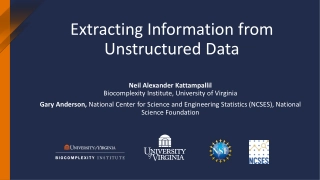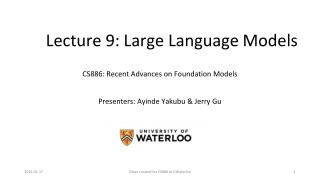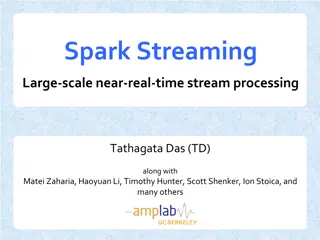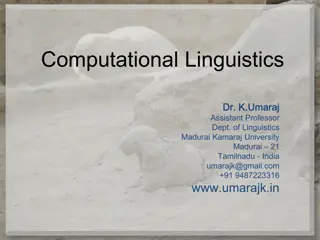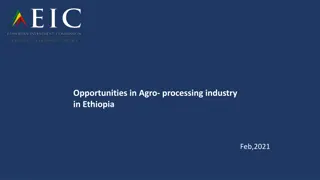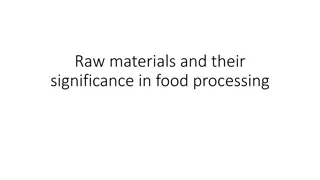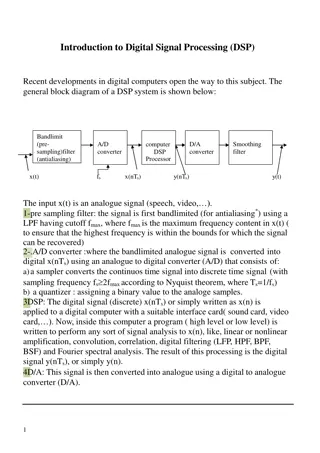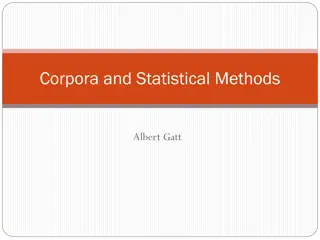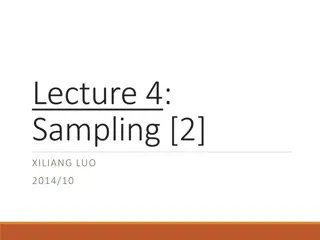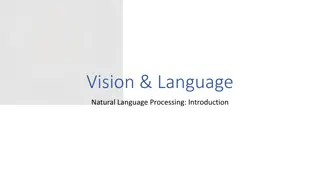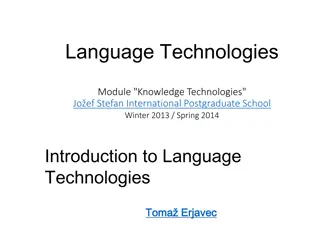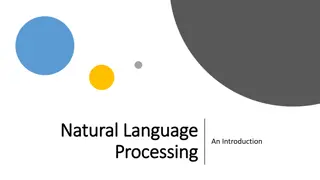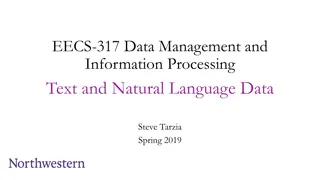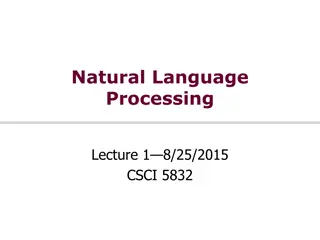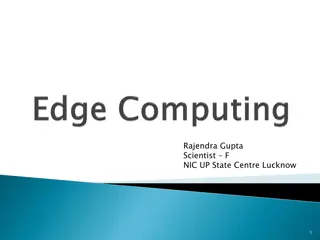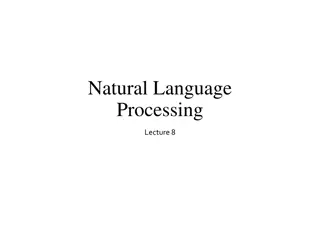Natural Language Processing in Education: Overview and Applications
Natural Language Processing (NLP) plays a crucial role in education by enabling computers to understand and generate human language. NLP is essential due to the abundance of machine-readable text, audio, and video data available today, leading to the development of conversational agents like Siri and Alexa. In education, NLP applications include improving language learning, automatic essay grading, and facilitating classroom discussions. The PETAL Lab at the University of Pittsburgh focuses on leveraging language processing technologies for educational purposes.
Download Presentation

Please find below an Image/Link to download the presentation.
The content on the website is provided AS IS for your information and personal use only. It may not be sold, licensed, or shared on other websites without obtaining consent from the author. Download presentation by click this link. If you encounter any issues during the download, it is possible that the publisher has removed the file from their server.
E N D
Presentation Transcript
Natural Language Processing and Applications in Education Diane Litman Professor, Computer Science Department Co-Director, Intelligent Systems Program Senior Scientist, Learning Research & Development Center University of Pittsburgh Pittsburgh, PA USA
Natural Language Processing (NLP) Getting computers to perform useful and interesting tasks involving human languages languages such as English, Spanish, Chinese, etc. as opposed to computer languages such as Python 2
Why is NLP needed? An enormous amount of machine readable text, audio, and video is now available Conversational agents such as Siri and Alexa are becoming an important form of human-computer communication
Roles for Language Processing in Education Learning Language (e.g., reading, writing, speaking) Automatic Essay Grading
Roles for Language Processing in Education Using Language (e.g., teaching in the disciplines) Dialogue Systems for STEM
Roles for Language Processing in Education Using Language (e.g., teaching in the disciplines) Classroom Discussion Dashboard Student Talk Specificity Low Medium S1 Some people they just ask for a job is just like, some money. It's like, I think she already knew that they weren't going to get it, but she, she couldn't do anything except just encourage them cause that's the only thing, like she [xx]. That's why she kinda supported it, but she already knew that they weren't going to get it. S1 She was already talking about how she didn't think that they were going to get it. Medium S2
Roles for Language Processing in Education Processing Language Summarizing Student Reflections
PETAL (Pitt Educational Technology And Language) Lab Learning Language Using Language Processing Language Haoran Zhang (5th year) Tazin Afrin (5th year) Luca Lugini (6th year) Mingzhi Yu (4th year) Ravneet Singh (2nd year) Luca Lugini (6th year) Ahmed Magooda (4th year)
NLP for Education Research Lifecycle Real-World Problems Systems and Evaluations NLP-Based Educational Technology Learning and Teaching Challenges! User-generated content Meaningful constructs Real-time performance Higher Level Learning Processes Theoretical and Empirical Foundations
Todays Talk: Learning Language Argumentative Writing / Argument Mining Algorithms for Argument Mining Applications in Automated Writing Assessment Summary and Current Directions
Research Question Can argument mining be used to better teach, assess, and understand argumentative text and speech? Approach: Technology design and evaluation System enhancements that improve student learning Argument analytics for teachers Experimental platforms to test research predictions
Argument Mining exploits the techniques and methods of natural language processing for semi-automatic and automatic recognition and extraction of structured argument data from unstructured texts. [SICSA Workshop on Argument Mining, July 2014]
Mining a Grade School Text-Based Essay for Evidence I was convinced that winning the fight of poverty is achievable in our lifetime. Many people couldn't afford medicine or bed nets to be treated for malaria . Many children had died from this dieseuse even though it could be treated easily. But now, bed nets are used in every sleeping site . And the medicine is free of charge. Another example is that the farmers' crops are dying because they could not afford the nessacary fertilizer and irrigation . But they are now, making progess. Farmers now have fertilizer and water to give to the crops. Also with seeds and the proper tools . Third, kids in Sauri were not well educated. Many families couldn't afford school . Even at school there was no lunch . Students were exhausted from each day of school. Now, school is free . Children excited to learn now can and they do have midday meals . Finally, Sauri is making great progress. If they keep it up that city will no longer be in poverty. Then the Millennium Village project can move on to help other countries in need. 11
Mining a College Essayfor Claims, Premises and their Support/Attack Relations (1)[Taking care of thousands of citizens who suffer from disease or illiteracy is more urgent and pragmatic than building theaters or sports stadiums]Claim. (2)As a matter of fact, [an uneducated person may barely appreciate musicals]Premise, whereas [a physical damaged person, resulting from the lack of medical treatment, may no longer participate in any sports games]Premise. (3)Therefore, [providing education and medical care is more essential and prioritized to the government]Claim. Claim (1) Premise(2.1) supports Claim(1) Premise(2.1) supports Claim(3) Premise(2.2) supports Claim(1) Premise(2.2) supports Claim(3) Claim(3) supports Claim(1) Claim (3) Premise (2.1) Premise (2.2) 14
Mining a High School Text-Based ClassroomDiscussionfor Claim, Evidence, Warrants Student Transcript Component S1 She s like really just protecting Willy from everything Like at the end of the book remember how she was telling the kids to leave and never come back claim evidence Like she s not even caring about them, she s carying about Willy. warrant S2 It s like she s concerned with him tryingto claim
Argument Mining Subtasks [Peldszus and Stede, 2013] Scope of today s talk Even partial argument mining can support useful applications
Todays Talk: Learning Language Argumentative Writing / Argument Mining Algorithms for Argument Mining Applications in Automated Writing Assessment Summary and Current Directions
Why Automatic Writing Assessment? Essential for Massive Open Online Courses (MOOCs) and tutoring systems Even in traditional classes, frequent assignments can limit the amount of teacher feedback 2
Using Natural Language Processing for Scoring Writing and Providing Feedback At-Scale IES Grant w. Rip Correnti and Lindsay Clare Matsumara Initial work Summative writing assessment via meaningful features that operationalize the EvidenceandOrganizationrubrics of RTA Current work Formative assessment for students and teachers Argument mining subtasks segmentation: spans of text segment classification: evidence from text (or not) 19
An Example Writing Assessment Task: Response to Text (RTA) MVP, Time for Kids informational text
Evidence Assessment via Argument Mining Summative: SCORE=4 I was convinced that winning the fight of poverty is achievable in our lifetime. Many people couldn't afford medicine or bed nets to be treated for malaria . Many children had died from this dieseuse even though it could be treated easily. But now, bed nets are used in every sleeping site . And the medicine is free of charge. Another example is that the farmers' crops are dying because they could not afford the nessacary fertilizer and irrigation . But they are now, making progess. Farmers now have fertilizer and water to give to the crops. Also with seeds and the proper tools . Third, kids in Sauri were not well educated. Many families couldn't afford school . Even at school there was no lunch . Students were exhausted from each day of school. Now, school is free . Children excited to learn now can and they do have midday meals . Finally, Sauri is making great progress. If they keep it up that city will no longer be in poverty. Then the Millennium Village project can move on to help other countries in need. Formative: Elaborate: Give a detailed and clear explanation of how the evidence supports your argument.
Automated Essay Scoring (AES) [Rahimi, Litman et al., 2017] ( 27
An Alternative Approach [Zhang & Litman, 2018] eRevise uses this rubric-based AES system Enhanced via word-embeddings [Zhang & Litman, 2017] Requires education experts to pre-encode knowledge of the source article Requires computer science experts to handcraft predictive features for AES We have also developed a co-attention-based neural network for source-dependent AES Increases reliability (not sure about validity) Eliminates human source encoding and feature engineering 28
Evaluation Data Source Excerpt Today, Yala Sub-District Hospital has medicine, free of charge, for all of the most common diseases. Water is connected to the hospital, which also has a generator for electricity. Bed nets are used in every sleeping site in Sauri... Essay Prompt The author provided one specific example of how the quality of life can be improved by the Millennium Villages Project in Sauri, Kenya. Based on the article, did the author provide a convincing argument that winning the fight against poverty is achievable in our lifetime? Explain why or why not with 3-4 examples from the text to support your answer. Evidence List: Yala sub district hospital has medicine medicine free charge medicine most common diseases water connected hospital hospital generator electricity bed nets used every sleeping site 30
Results CO-ATTN significantly increases Quadratic Weighted Kappa of eRevise AES eRevise SELF-ATTN CO-ATTN MVP Space .653 .632 .701 .690 .718 .702 31
Results CO-ATTN significantly increases Quadratic Weighted Kappa of eRevise AES Also improves neural baseline, and for Kaggle data eRevise SELF-ATTN CO-ATTN MVP Space .653 .632 .701 .690 .718 .702 32
Automatic Writing Evaluation (AWE) NPE indicates the breadth of unique topics SPC indicates the number of unique pieces of evidence A matrix of these two matches each essay to appropriate feedback 33
Revision and Formative Feedback Screenshot 34
Spring 2018 Pilot Deployment [Zhang, Magooda, Litman et al., 2019] Seven 5th and 6th grade teachers in two public rural parishes in LA Students wrote/revised an essay using eRevise for RTAmvp 143 students completed all tasks Mean RTA Evidence scores improved from first to second draft Human graders (p 0.08) AES in eRevise (p = 0.001) AES feature values increased from first to second draft NPE (p 0.003) SPC_TOTAL_MERGED (p 0.001) 35
2018-2019 Deployment A new study with almost 50 teachers in Louisiana eRevise used for both RTAmvp and RTAspace More teacher support as well as a control- condition Analysis in progress 36
Additional Directions Automatic extraction of evidence from source LDA / turbo-topic [Rahimi & Litman, 2016] Attention from neural network [Zhang & Litman, in progress] Revision analysis across drafts extraction/classification of revisions [Zhang & Litman, 2015, 2016] web-based revision assistant [Zhang et al., 2016] editor roles [Afrin & Litman, 2019]
Todays Talk: Learning Language Argumentative Writing / Argument Mining Algorithms for Argument Mining Applications in Automated Writing Assessment Summary and Current Directions
Context-Aware Argument Mining [Nguyen & Litman 2015, 2016, 2017] Global: Writing prompts as supervision to seeded LDA argument and domain word extraction Local: Surrounding text as a context-rich representation of argument components multi-sentential windows or Bayesian topic segmentation Argument mining subtasks segmentation: spans of text segment classification: major claim, claim, premise relation identification: e.g., support or not Argument mining subtasks segmentation: spans of text segment classification: major claim, claim premise
Persuasive Essay Corpus [Stab & Gurevych, 2014] Major- claim(1) Support Claim(2) 40
Argument & Domain Words: Creating Seeds Development corpus 6794 persuasive essays with post titles collected from www.essayforum.com 10 argument seeds agree, disagree, reason, support, advantage, disadvantage, think, conclusion, result, opinion 3077 domain seeds in title, but not argument seeds or stop words
Post-Processing LDA Output Compute three weights for each LDA topic Domain weight is the sum of domain seed frequencies Argument weight is the number of argument seeds Combined weight = Argument weight Domain weight Find the best number of topics with the highest ratio of combined weight of top-2 topics The argument word list is the LDA topic with the largest combined weight given the best number of topics
Resulting Argument/Domain Words 36 LDA topics 263 (stemmed) argument words seed variants (e.g., believe, viewpoint, argument, claim) connectives (e.g., therefore, however, despite) stop words 1806 (stemmed) domain words Topic 1 (argument words) reason exampl support agre think becaus disagre statement opinion believe therefor idea conclus ... Topic 2 (domain words) citi live big hous place area small apart town build communiti factori urban ... Topic 3 (domain words) children parent school educ teach kid adult grow childhood behavior taught ...
Feature Sets for Argument Component Classification Nguyen16 (Nguyen & Litman 2016) Stab14 (Stab & Gurevych 2014) Nguyen15 (Nguyen & Litman 2015) 1-, 2-, 3-grams Argument words as unigrams Verbs, adverbs, presence of model verb Discourse connectives, Singular first person pronouns Lexical 1. Numbers of common words with title and preceding sentence 2. Comparative & superlative adverbs and POS 3. Plural first person pronouns 4. Discourse relation labels (I) (I) Same as Stab14 Production rules Argument subject-verb pairs Parse (II) Nguyen15 v2 (II) Tense of main verb #sub-clauses, depth of parse tree Same as Stab14 #tokens, token ratio, #punctuation, sentence position, first/last paragraph, first/last sentence of paragraph #tokens, #punctuation, #sub- clauses, modal verb in preceding/following sentences Structure (III) (III) Same as Stab14 Context (IV) (IV)
Feature Sets for Argument Component Classification Nguyen16 (Nguyen & Litman 2016) Stab14 (Stab & Gurevych 2014) Nguyen15 (Nguyen & Litman 2015) 1-, 2-, 3-grams Argument words as unigrams Verbs, adverbs, presence of model verb Discourse connectives, Singular first person pronouns Lexical 1. Numbers of common words with title and preceding sentence 2. Comparative & superlative adverbs and POS 3. Plural first person pronouns 4. Discourse relation labels (I) (I) Same as Stab14 Production rules Argument subject-verb pairs Parse (II) Nguyen15 v2 (II) Tense of main verb #sub-clauses, depth of parse tree Same as Stab14 #tokens, token ratio, #punctuation, sentence position, first/last paragraph, first/last sentence of paragraph #tokens, #punctuation, #sub- clauses, modal verb in preceding/following sentences Structure (III) (III) Same as Stab14 Context (IV) (IV)
Feature Sets for Argument Component Classification Nguyen16 (Nguyen & Litman 2016) Stab14 (Stab & Gurevych 2014) Nguyen15 (Nguyen & Litman 2015) 1-, 2-, 3-grams Argument words as unigrams Verbs, adverbs, presence of model verb Discourse connectives, Singular first person pronouns Lexical 1. Numbers of common words with title and preceding sentence 2. Comparative & superlative adverbs and POS 3. Plural first person pronouns 4. Discourse relation labels (I) (I) Same as Stab14 Production rules Argument subject-verb pairs Parse (II) Nguyen15 v2 (II) Tense of main verb #sub-clauses, depth of parse tree Same as Stab14 #tokens, token ratio, #punctuation, sentence position, first/last paragraph, first/last sentence of paragraph #tokens, #punctuation, #sub- clauses, modal verb in preceding/following sentences Structure (III) (III) Same as Stab14 Context (IV) (IV)
A Sample of our Experimental Results 10x10-fold cross validation Best values in bold * means significantly worse than Nguyen16 Stab14 Nguyen15 Nguyen16 Accuracy 0.787* 0.792* 0.805 Kappa 0.639* 0.649* 0.673 Precision 0.741* 0.745* 0.763 Recall 0.694* 0.698* 0.720 LDA-enabled and other proposed features improve performance
Cross-Topic Evaluation 11 single-topic groups E.g., Technologies (11 essays), National Issues (10), School (8), Policies (7) 1 mixed topic group of 17 essays (< 3 essays per topic) Stab14 Nguyen15 Nguyen16 Accuracy 0.780* 0.796 0.807 Kappa 0.623* 0.654 0.675 Precision 0.722* 0.757* 0.771 Recall 0.670* 0.695* 0.722 Proposed features are more robust across topics Larger performance difference with Stab14 baseline Performance matches 10X10 fold experiment







